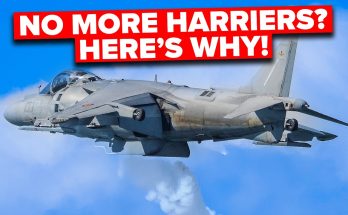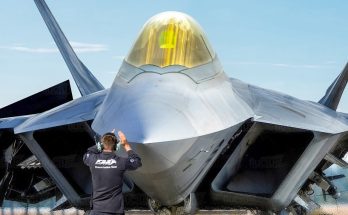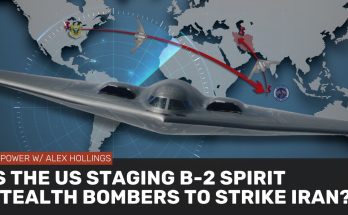The U.S. bomber fleet is widely regarded as one of the most powerful and capable in the world. It is a critical component of the U.S. military’s strategic deterrence and global power projection capabilities. The power of the U.S. bomber fleet lies not only in the advanced technology and performance of its aircraft but also in the flexibility, versatility, and reliability these bombers provide in a range of military operations. Here’s what makes the U.S. bomber fleet so powerful:
1. Nuclear and Conventional Strike Capabilities
The U.S. bomber fleet plays a dual role, capable of both nuclear and conventional strikes. The ability to deliver both types of munitions makes it a versatile tool for deterrence and direct combat operations. Bombers like the B-52 Stratofortress, B-1B Lancer, and B-2 Spirit can carry nuclear bombs and cruise missiles, making them a key element of U.S. nuclear triad. Their long range and high payload capacity allow them to deliver these weapons precisely, regardless of geographic location.
The B-52, which has been in service since the 1950s, can carry a variety of conventional bombs and precision-guided munitions (PGMs), giving it immense flexibility in conflict. On the other hand, the B-2 Spirit is capable of carrying nuclear bombs while being virtually undetectable to radar, thanks to its stealth technology. This combination of nuclear and conventional capabilities makes the U.S. bomber fleet a powerful and adaptable force in any combat environment.
2. Global Reach
One of the defining features of the U.S. bomber fleet is its ability to project power anywhere in the world. The bombers have the range to reach virtually any target on the planet without the need for forward basing, making them highly effective in power projection. The B-2 Spirit, for instance, has an unrefueled range of over 6,000 miles, and the B-52 can fly over 8,800 miles with its maximum fuel load. Even the B-1B Lancer, which has a slightly shorter range, can be refueled in air, extending its operational range indefinitely.
This global reach allows the U.S. to respond rapidly to any threat, whether it’s deterring an adversary through the mere presence of bombers or delivering precision strikes in a conflict. The fleet’s long-range capability is crucial for maintaining a credible deterrence posture, as bombers can be deployed in various regions around the world on short notice.
3. Advanced Technology and Stealth
The U.S. bomber fleet is equipped with cutting-edge technology that enhances its effectiveness in modern warfare. The B-2 Spirit, for instance, is a prime example of stealth technology, designed to evade detection by enemy radar and air defenses. Its low radar cross-section, combined with advanced avionics and defensive systems, allows it to penetrate the most heavily defended airspace with minimal risk.
Meanwhile, the B-1B Lancer features a variable-sweep wing design that offers both speed and maneuverability, along with advanced electronic warfare systems. This makes it particularly useful in environments where air defenses are sophisticated. All bombers in the fleet are equipped with precision targeting systems, allowing them to deliver highly accurate strikes while minimizing collateral damage, a key asset in modern combat.
4. Versatility and Flexibility
The U.S. bomber fleet’s versatility is a significant factor in its power. Unlike other military aircraft that are specialized for specific roles, bombers can perform a wide range of missions. They can conduct strategic deterrence missions, close air support, intelligence gathering, and tactical strikes. Furthermore, bombers are capable of carrying a variety of payloads, from precision-guided munitions to cluster bombs, giving them the flexibility to adapt to changing battlefield requirements.
In addition to their conventional and nuclear strike roles, bombers can be used in psychological operations, reconnaissance, and providing air superiority support. Their ability to conduct long-duration missions and deliver a wide array of munitions ensures they remain relevant in both modern and future warfare.
5. Deterrence and Strategic Importance
Perhaps the most important aspect of the U.S. bomber fleet is its role in deterrence. The very presence of bombers in the sky sends a powerful message to potential adversaries, signaling that the U.S. is prepared to respond to aggression with overwhelming force. This presence is particularly significant in the nuclear realm, where the U.S. bombers, as part of the nuclear triad (land-based missiles, submarine-launched missiles, and strategic bombers), ensure that any adversary contemplating an attack on the U.S. would be met with devastating retaliation.
The ability to launch a nuclear strike from a bomber, combined with the option for rapid deployment and global reach, makes the U.S. bomber fleet a cornerstone of the nation’s defense and a crucial element of its global strategic posture.
Conclusion
The power of the U.S. bomber fleet lies in its unmatched versatility, technological superiority, and global reach. These aircraft are capable of performing a variety of missions, from nuclear deterrence to conventional warfare, all while maintaining the flexibility to adapt to dynamic combat environments. With a fleet that combines advanced stealth, precision strike capabilities, and an ability to project power globally, the U.S. bomber fleet remains one of the most formidable components of the U.S. military, ensuring that America can respond to threats anywhere in the world, at any time.



